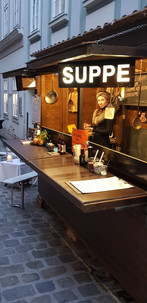Beef Bone Broth
- Augora Fermente

- Aug 1, 2021
- 3 min read
I do struggle with the aesthetic of the word for the outcome of a long cooked soup on the basis of mainly bones. The english "beef bone broth" or "bone tea" sounds equally frightening as the german "Brühe", which to an Austrian sounds like a filthy, dirty liquid. Merely the french "fond" or the italian "brodo" also manage to find a word that expresses the sensational taste that derives from a this long cooking journey.

My butcher overly cheerful yelled from the other end of the market when he saw me coming along.... "I have bones from angus, want some?"
His animals graze in the most beautiful natural reserve close to Mattersburg. The meat is divine and so are the bones.
Here is what to do with them:
Beef Bone Broth (10 liter pot)
3 kg bones (best is a mixture of: 1/3 marrow, 1/3 white bones, 1/3 meat bones)
1 onion
1 small leek
2 carots
1/3 celery
thyme & peppercorns
salt (added after cooking)
special treatment bone marrow:
making this broth results in incredible amounts of fat - tallow to be precise. I find it hard breaking that the wonderful bone marrow will eventually take a bath in the tallow and is not separable from it . This is why I take it out before cooking and use it otherwise (i.e. Risotto Milanese).
Soak the bones in ice water for at least an hour - the more the better - while renewing the water every now and then. After that press out the marrow with your fingers. The marrow needs to be very chilled. This is why I do the soaking in the fridge. If the marrow at room temp you hardly can push it out of the bone. Mind: some bones have little fish bone like cross-brazes that you can hurt you when you push the marrow out. Best is to wear rubber gloves. One you harvested the marrow - freeze it or use it instantly.
The bones will be roasted on a pan - do not stack them though - at 220 degrees celsius for 20-30 minutes. Then they go into the pot together with thyme & pepper. Start heating the water - they bones should simmer for 18 hours. Remove scum that surfaces and make sure you are not boiling them heavily.
You might be facing the following challenges when you do this in a home environment:
The long cooking time may result in water that evaporates. If that happens your simmering broth will start boiling and then even more evaporates. Tip: use a well isolated pot with thick walls and a good lid
Some stoves will turn of after a while for security reasons. Tip: instead of cooking the broth on the stove you can put it into the oven at 120 degree celsius. Here as well a thick-walled pot will be very beneficial
90 minutes before the end of the cooking time add the roughly chopped vegetables.
Skim off the fat. Easiest solution is to discard all the bones and vegetables. After the soup has cooled down put it in the fridge. The next day you will have a thick layer of fat floating on top that can be easily removed. Leave in a little of the fat though - as it does taste good.
Now only start salting. Reheat the soup and add the salt. he salt content should be between 5-10% - I always start in the middle with 7% and add more if required. This means if you harvest 5 Liters of soup you add 35g of salt.
Now you beef bone broth is finished.
Fill the hot liquid into sterilized glas bottles. Pasteurize in a steamer for 50 minutes. If you do not have a steamer you can also put them in a broad cooking pot filled with water. The bottles should be 2/3 under water in order for the pasteurisation to work well. Alternatively you can also freeze the soup - if cooled down again.


















Comments